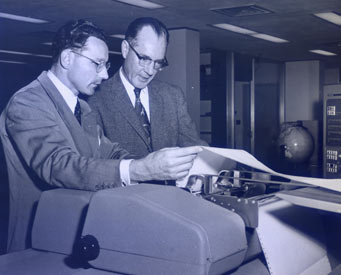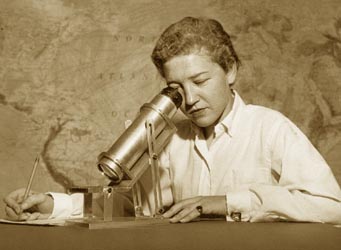
IBM staff member John P. (Gianpiero) Rossoni (left), the author's father, stands with Project Moonwatch organizer Fred Whipple at the IBM 704's printer in the MIT Computation Center in October 1957.
Phil Rossoni
Last week, on October 4th, the whole world took note of the 50th anniversary of the launch of Sputnik 1, the first artificial satellite. Today, the 11th, marks the anniversary of another Sputnik event that also deserves notice — especially for the long-time Sky & Telescope readers who helped to make it happen.
It was an exciting year for science in 1957 and especially for amateur astronomy. The United States was committed to launching the first artificial satellite into orbit as a part of the International Geophysical Year. To track this satellite, the Smithsonian Astrophysical Observatory (now known as the Harvard-Smithsonian Center for Astrophysics) had assembled Project Moonwatch. For this ambitious operation, batteries of amateur volunteers planned to watch through telescopes and record exactly when and where "Earth's second moon" would cross the local meridian of their sky — thereby providing data needed to compute the object's exact orbit, predict its future positions, and track changes in the orbit due to atmospheric drag.
One of the first mass-produced computers, an IBM 704 located at the MIT Computation Center, stood waiting to accept times and positions from the Moonwatch groups and calculate the orbit. IBM supplied four staff members to help with the calculations: John P. (Gianpiero) Rossoni, John Greenstadt, Thomas Apple, and Richard Hatch. Many other projects were competing for use of the new computer, and with no satellite yet in orbit, the team had access to only a small fraction of the computer's time.

A typical Moonwatch telescope used a mirror beyond its objective lens to allow the observer to view the sky comfortably for hours at a time.
Smithsonian Astrophysical Observatory
With the surprise launch of Sputnik early on the morning of October 4th, the IBM team and Project Moonwatch sprang into high gear, working around the clock from 11 that morning to 7 a.m. the following day. Complicating the process of fixing the orbit was the fact that there were three separate objects to track: the Sputnik satellite payload (beeping by radio), a nose cone, and a much larger and more visible (and, at 4 tons, heavier) spent booster rocket. Spurious sightings abounded until the objects were sorted out.
It was not until a week later, on the morning of October 11, 1957, that enough accurate sightings of the booster rocket produced the first "satisfactory orbit" calculated by the IBM 704. The event was heralded by the news media, which were hungry for any glimmer of a US response to the humiliation of the Soviets beating the United States into space. Amateur astronomers became something like national heroes.
The cycle continued of Moonwatch sightings, IBM calculations, and new predictions of the next good satellite appearances — providing valuable information about the forces perturbing the orbit, and providing the news media with local predictions of when the public could go out and watch the Soviet missile passing over their homes. Adjustments were made to the computer program to more accurately forecast the orbit of the booster rocket. The booster was calculated to dip within 143 miles of the ground at perigee, and thus it became more and more subject to atmospheric drag as the days went on. The booster rocket is believed to have met its end, burning up in the atmosphere, over the most likely location for a celestial object to impact the earth, the ocean.
More on Project Moonwatch is in the October 2007 issue of Sky & Telescope.
 0
0
Comments
You must be logged in to post a comment.